How long did C&S boxcars stay in service?
12




















12
How long did C&S boxcars stay in service?
|
Specifically, in 1925, presumably there would be plenty of Phase III cars on the road.
What about the Phase II truss-rod cars? Would they make up a very small percentage of the fleet by 1925, or were there still a lot of them around? And St. Charles cars? Would any of them still be in service? Thanks, Jeff. (As for lettering, does a 50/50 split between block and button sound about right, or did the button herald get applied fast enough that it would be predominant even by 1925?) |
Re: How long did C&S boxcars stay in service?
|
Photos show Ph-III on the West of Idaho Springs scraptrain....I guess that after that period most robust Ph-III cars went to the Leadville-Climax line. http://digital.denverlibrary.org/cdm/fullbrowser/collection/p15330coll22/id/42539/rv/singleitem/rec/37
note the placard on the door. Certainly at least one Ph-II car up Clear Creek to the last. Checking out more of these pictures would answer as to what percentage. 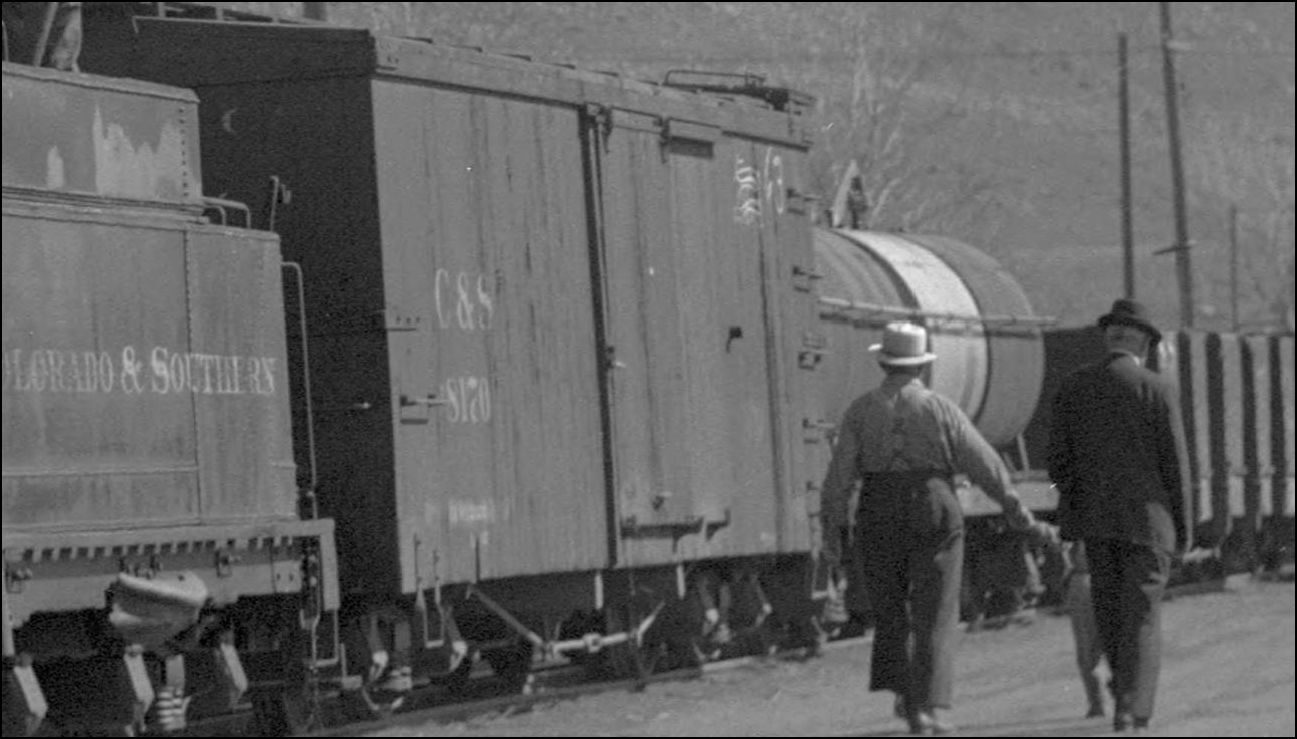 http://digital.denverlibrary.org/cdm/fullbrowser/collection/p15330coll22/id/42650/rv/singleitem/rec/78
UpSideDownC
in New Zealand |
Re: How long did C&S boxcars stay in service?
|
All right, I'm a bit new to this boxcar spotting scene, so I don't know exactly what I'm looking for.
Would it be fair to say that this picture (from 1935) shows two Phase II cars followed by a Phase III? 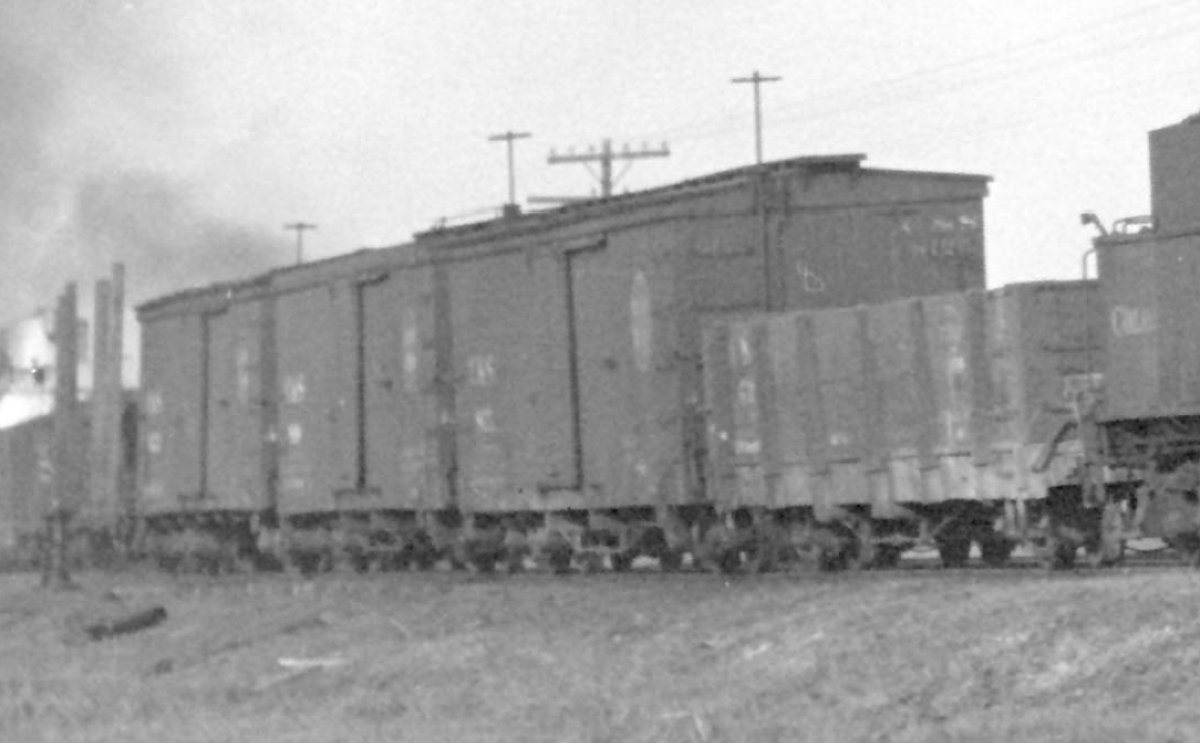 http://digital.denverlibrary.org/cdm/singleitem/collection/p15330coll22/id/45817/rec/5 What distinguishes a St. Charles from a Phase II? Wood vs. metal roof? (And is there a Phase I in between, or does Phase I = St. Charles?) Is this all in the second Harry Brunk book? (I only have the first one.) Thanks, Jeff. |
Re: How long did C&S boxcars stay in service?
|
Brother Derrell's contribution to the great book on C&S freight and passenger cars covers this pretty nicely. Another source of information is the extensive research compiled by brother Derrell in his beautiful C&S plans of the box cars. Derrell has also written several articles over the years about the St. Charles C&S freight cars. As a guy with a significant "St. Charles problem" these articles are essential. Standing on brother Derrell's shoulders, I wrote a series of articles in the Bogie and the Loop about the lettering of the various C&S boxcars with plans showing the various Brunk "types" and how their lettering changed. Basically, Harry Brunk's classification system is a way to categorize the C&S narrow gauge boxcars according to vintage, as well as to where the various types of boxcars fit into the chain of rapidly evolving C&S narrow gauge freight car technological evolution. As opposed to the Rio Grande, the C&S narrow gauge was "Joe down to business" when it came to improving freight car design. The St. Charles boxcars were delivered to the UPD&G in beginning in 1897 and to the C&S beginning in 1898. Besides being lettered differently, these two deliveries of "modern" boxcars were basically identical. Remember, at the time all the C&S had was the worn out equipment inherited from various predictors. These new modern "St. Charles" freight cars had rigid arch bar trucks and bolted together truck bolsters, and of course wood frames. Brother Derrell's plans for these boxcars cars go into great detail about how many survived into the 1930s. The St. Charles coal cars, reefers and stock cars shared the bolted together rigid arch bar trucks and the bolted bolsters. They were also typed by Harry Brunk as "Type 1" So, if you see a C&S freight car (in the 1920s or 1930s with arch bar trucks and truss rods, you are probably looking at a "type 1" freight car. There are a couple of exceptions which brother Derrell can address or you can look up in his writings. The C&S also experimented with variations of boxcars using different trucks and bolsters. Harry lumped these experiments into "type 1". Brother Derrell can speak to that. The "type 2" boxcars, stock cars and coal cars were a big step up in technology in that they had Bettendorf cast steel bolsters and trucks. The frames for these cars however were wood. So, if you see a C&S freight car with cast Bettendorf trucks and truss rods you are looking at a "type 2" car. The "type 3" boxcars, coal cars, reefers and stock cars were yet another jump up in technology with cast steel frames and Bettendorf trucks. So, if you see a C&S narrow gauge freight car with cast Bettendorf trucks and no truss rods you are looking at a "type 3" car. Respectfully submitted, Robert Stears Sent from my iPhone
|
Re: How long did C&S boxcars stay in service?
|
Thanks for that intro, Robert. Very helpful.
Chris also sent me some stuff which made me realise that Harry Brunk’s boxcar article is in the first book (I just somehow missed it when looking through the table of contents). Harry indicates that some of the St Charles boxcars (which are quite similar to the Phase I cars but have some detail differences) survived in service all the way to the end of narrow gauge operations on the Climax line (1943), and on the RGS (1952). And to answer one of my other questions, the roofs varied over all the phases. The distinguishing trait between Phase I and II was the move from arch-bar to Bettendorf trucks. Sadly, the trucks are pretty hard to make out in many of the photos, so it’s hard to judge the prevalence of the different phases. Cheers, Jeff. |
Re: How long did C&S boxcars stay in service?
|
Most of the photographic evidence is from well after the period I model, but the pictures still provide some clues about the equipment mixes. In the captions, I've used "Type 1/2" to indicate a car whose trucks I can't see well enough to differentiate.
Sheridan, 1931. 3 Type 1/2 and 4 Type 3 cars. 1 block lettered, 6 button heralds.  http://digital.denverlibrary.org/cdm/singleitem/collection/p15330coll22/id/43131/rec/93 Waterton, 1935. 1 Type 1/2 and 2 Type 3 cars. All button heralds. 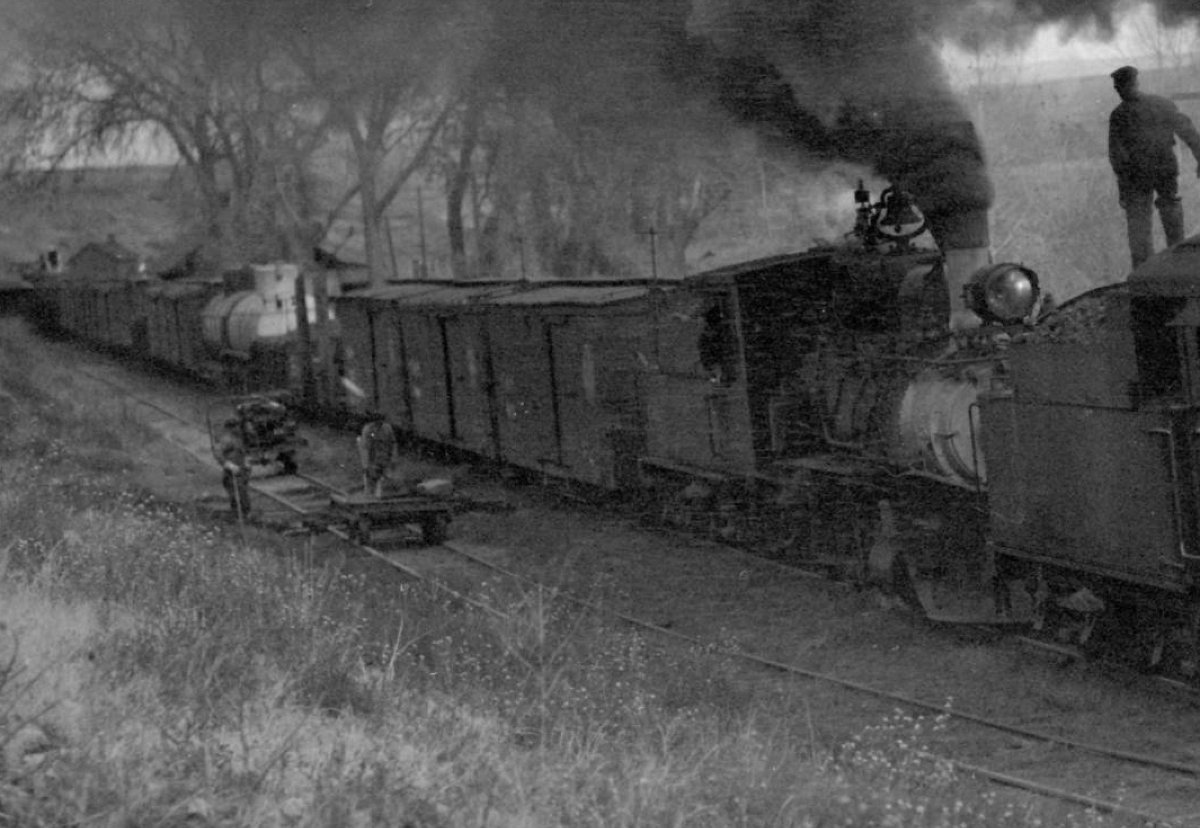 http://digital.denverlibrary.org/cdm/singleitem/collection/p15330coll22/id/45813/rec/85 Denver, 1935. 3 Type 1/2 and 6 Type 3 cars. All button heralds, but 2 block lettered coal cars.  http://digital.denverlibrary.org/cdm/singleitem/collection/p15330coll22/id/42584/rec/160 Denver, 1936. In order (from engine): Type 2, Type 1, Type 3, Type 1/2, Type 3, Type 3. Heralds indistinct (but at least predominantly button). 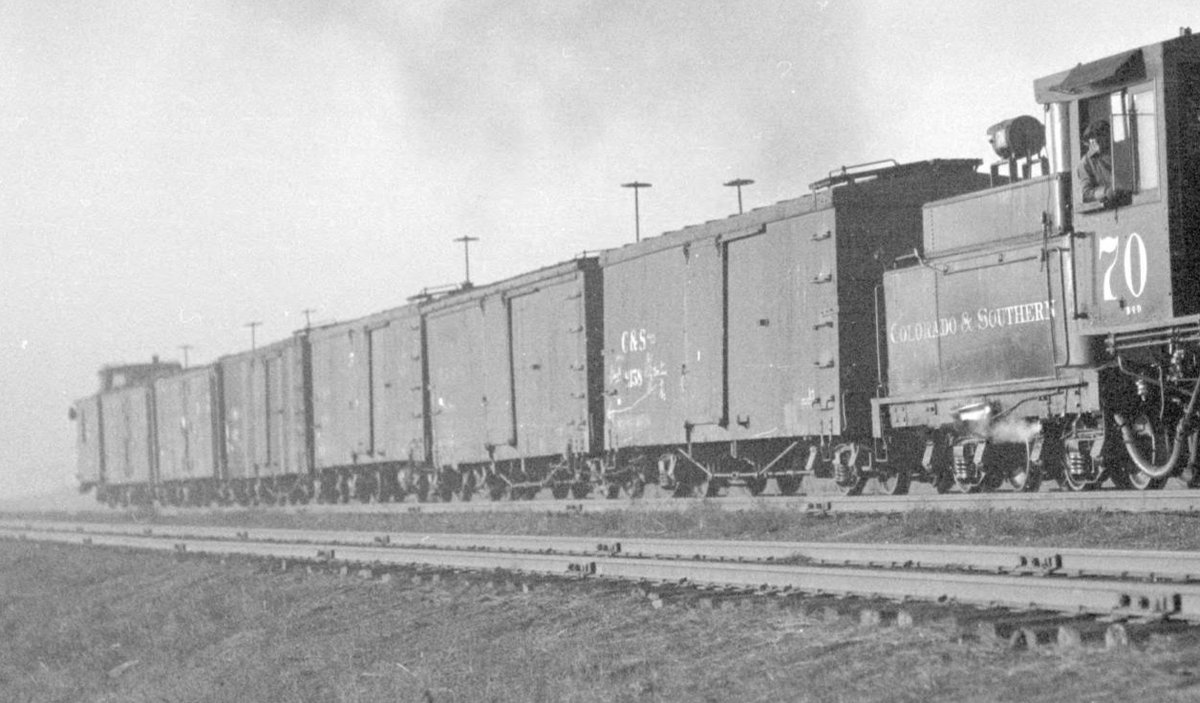 http://digital.denverlibrary.org/cdm/singleitem/collection/p15330coll22/id/42586/rec/125 Alma, 1937. 3 Type 3 cars. 1 block lettered and 2 button heralds.  http://digital.denverlibrary.org/cdm/singleitem/collection/p15330coll22/id/42470/rec/38 There are a lot more pictures from the later 30's and early 40's, but that's after abandonment of the parts I model so I ignored them. It's varied enough that for my road (ca. 1925), I think I'll have all 3 types represented (and both heralds), but with no particular plan toward ratios of the various types/heralds. Cheers, Jeff. |
Modelling a Type 3 boxcar in HOn3...
|
So it occurs to me that I have this MTL reefer that I no longer have a spot for (it's red, you see), and I was wondering if the reefers used the same steel underframes as the boxcars?
In other words, can I kitbash a LaBelle St. Charles boxcar with my MTL reefer underframe and have a reasonable Type 3 boxcar? Alternatively, anyone have any Grandt Line steel underframe boxcar kits they're not using? Thanks, Jeff. |
Re: Modelling a Type 3 boxcar in HOn3...
|
This post was updated on .
Jeff,
Consider this photo by Frank Duca, dated in 1926 of freight cars on the siding at Baileys, within one year of your "era". I have owned postcard sized contact prints from the original negatives for may years and discovered many interesting tidbits by examining the original photos under extreme magnification using a surgical dissecting microscope. It is amazing how many details hide in the silver grains! 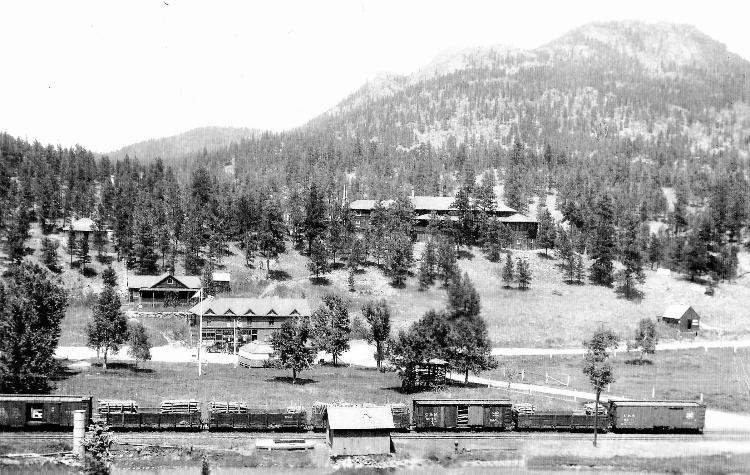 From right to left (east to west): Boxcar 81xx is a 1908 ("Phase 2") boxcar recently repainted and lettered in the "button" scheme. There doesn't seem to be a black background behind the button. The coal car between the two boxcars is a St Charles 1897 or 1898 car (the 4 extra stake pockets are the identifying feature; under magnification, the 4 individual corner irons on the left end are visible). No lettering is discernable. The boxcar 8045 is a 1898 St Charles boxcar. The car has been shopped, but only the side door and a vertical piece of new siding have been repainted. The car has been re-lettered in the button scheme, but mostly over the weathered original paint job. Again there is no hint of a black background to the button herald. Under magnification, parts of the original St Charles Roman lettering scheme are faintly visible on the side to the left of the door. The original cover board over the top side door runner has been removed, but the two brackets at each end of the door runner remain. The next three coal cars are 1902 ("Phase 1") coal cars. The corner angle irons are all one piece. There are no extra stake pockets. Under magnification, parts of the box herald with "The Colorado Road" slogan are faintly visible between the middle stakes of the two cars to the left of the pump house. The boxcar to the left of the coal cars is number 812x, another 1908 "Phase 2" car, still in the as delivered block C&S monogram. A companion print, that I don't have an enlargement of, shows one additional boxcar out of frame to the left, boxcar 8300, a 1909-1910 ("Phase 3") SUF boxcar. It is also still in its as delivered block C&S monogram. The car siding and doors are heavily weathered. The boxcar behind the engine in the 2nd photo that you posted yesterday morning, number 8032, is in fact a St Charles boxcar--the two layer upper fascia board on the sides is the spotting feature: 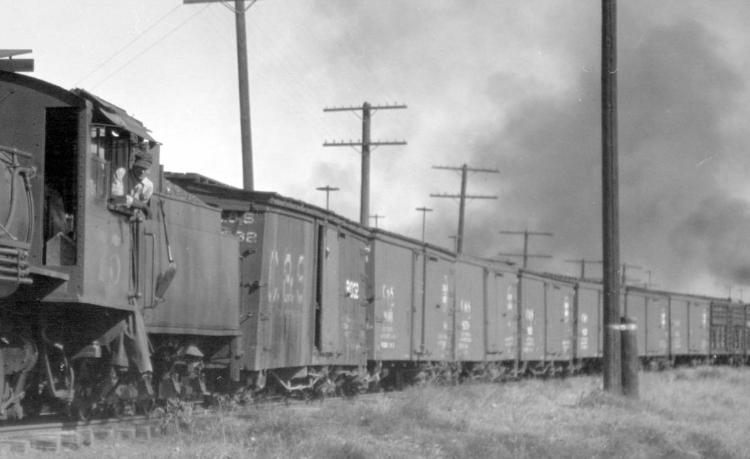 The car behind boxcar 8032 is a SUF boxcar that has had its metal roof replaced by a wooden roof. The last two cars ahead of the caboose in your next photo appear to be SUF reefers, substantiating Derrell's theory that yellow reefers in B&W photos are often close in tonal values to boxcar red cars: 
Jim Courtney
Poulsbo, WA |
Re: Modelling a Type 3 boxcar in HOn3...
|
In reply to this post by Jeff Young
In other words, can I kitbash a LaBelle St. Charles boxcar with my MTL reefer underframe and have a reasonable Type 3 boxcar?
Alternatively, anyone have any Grandt Line steel underframe boxcar kits they're not using? Why not just repaint and re-letter the red reefer? Soaking the car for several days in full strength Simple Green usually removes paint without marring the plastic body or its details. Decal sets are available from Thinfilm. The Gandt Line web page http://www.grandtline.com/products/mrr/mrr%20kits/rolling_stock_and_locos.html suggests that the SUF boxcars and stock car kits are available, two to a package, direct from Grandt Line only. And the kit for little 1005 / 1008 sure is cute!
Jim Courtney
Poulsbo, WA |
Re: Modelling a Type 3 boxcar in HOn3...
|
Thanks for the great info, Jim. Particularly the part about "The Colorado Road" herald on the coal car. I'll definitely have to add one of those somewhere on my roster.
I have the Grandt Line caboose kit, and tried to order the SUF boxcars, but they never arrived. I already have a yellow reefer in each of block lettered and button herald, and given their relative scarcity I probably don't need a third. But I did find a guy selling the Grandt Line SUF boxcars kit, so perhaps I'll noodle a bit more on converting vs. repainting the red reefer. Cheers, Jeff. |
Re: Modelling a Type 3 boxcar in HOn3...
|
Coronado Scale Models in Phoenix should be able to help you, Jeff.
UpSideDownC
in New Zealand |
Re: Modelling a Type 3 boxcar in HOn3...
|
In reply to this post by Jeff Young
Jeff, though my method is not exact, I suggest you construct a couple time lines.
On one, note the years of the various herald changes and paint schemes. I would start with 1890 on the left and extend to 1938 or 1940 to the right. On a second, or as part of the first, you can also note the deliveries of the various new equipment. Make a mark on the year (or years) you choose to model. As a rule, the further your modeling period is to the left of the line, the fresher the paint and lettering will be; after 1929, it is likely maintenance was deferred, and heralds will be faded the closer you get to 1938-40. The exception to this may be the Leadville cars. In your era, in the 20s, you will probably have a lot of fresh circular trademarks, and some block lettering both fresher and faded. There may also be some Roman lettering lingering on the St. Charles cars too. I model the end of this period, so most all my lettering is weathered. Photos indicate examples of block lettering persisted to the end, and now that Jim has alerted me to the nuances of the Phase I cars, I may also sneak some Roman lettering behind a circular trademark on one of my planned Phase I coals. Overall, the C&S had a similar number of coals and boxcars. I have not studied the early rosters, but I suspect there were lots of early boxcars in service when the 1897-8 St. Charles cars were ordered, so orders for wood frame, archbar cars (Phase Ia and Ib) have a ratio of 6 coals to one boxcar. By the time the Phase II cars were ordered in 1907-8, 2 coals were ordered for each boxcar. However when the Phase III cars were ordered in 1909-10, it was time to invest in boxcars, and almost five boxcars were ordered for each coal. By my analysis, which is inexact, if you had 23 boxcars and coals: -you would have one Phase I box and six coals; -two Phase II boxes and three coals; -and nine Phase III boxes and two coals. There would also be some stockcars, flat cars and refers. The point being there were a LOT of Phase I coals, and a LOT of Phase III boxcars, and a handful of the rest. While photos tell the true tale, the number of cars built may also be indicative of the number of a particular type of car that appear in a train. Derrell has pointed out that refers tended to travel in pairs, and this may be due to transshipment from a standard gauge car (on the D&RGW, one SG car filled two NG cars). I am using these ratios as I build my roster. (And this analysis does not include wrecks, or equipment assigned to non-revenue service). Generally the Trainmaster collected steel underframe cars at Leadville in 1938. The order to retrieve cars and send them to Leadville prior to abandonment suggests a very keen awareness of the condition of all the rolling stock, and I suggest the equipment in the best condition was reserved for this assignment. I leave it to you to find the train order and check the roster: I suspect some non-SUF cars made the cut.
Keith Hayes
Leadville in Sn3 |
Re: Modelling a Type 3 boxcar in HOn3...
|
Thanks for that, Keith. I was unaware of the different mixes of cars in the early vs. late runs.
Of course as Murphy would have it, my current fleet is nearly exactly backwards. But in the places where I need additions, I can at least keep it in mind for those. Cheers, Jeff. PS: interesting bit about the reefers-in-pairs. One of those things that's obvious only in hindsight. |
Re: Modelling a Type 3 boxcar in HOn3...
|
In reply to this post by Jim Courtney
I've been wondering about the Grandt SUF boxcar kits in HOn3. They have a 13 rib outside Murphy roof (according to the kit instructions helpfully photographed in an old Ebay listing). I'm trying to build cars correct for around 1916, and despite some digging in various sources I haven't been able to figure out yet whether this is a correct roof for that time frame. Can anybody help with this?
many thanks in advance! John John Greenly Lansing, NY
John Greenly
Lansing, NY |
Re: Modelling a Type 3 boxcar in HOn3...
|
This post was updated on .
The 13 rib roofs on the SUF boxcars, with all the little edge clamps, were the original roof, as built in 1909-1910. The USSA appliances were added sometime around 1914-1916.
It is my understanding that the 9 rib roofs, with wide ribs and no edge clamps (kinda like the rebuilt D&RGW 3000 series boxcar roofs) were replacement roofs applied as some cars were re-shopped in the mid 1920s, when the button monogram lettering began to appear. A few of of the SUF boxcars received wood replacement roofs, like on the phase one boxcars. The stock Grandt kits for the SUF boxcar in HOn3 (the Overland Sn3 kit, produced by Grandt for Overland) would be appropriate for 1916. I hesitate to start a controversy, but IMHO the Grandt and Overland kits in HOn3 and Sn3 respectively, are too short by about 2.5 to 3 scale inches. I think that Grandt created the tooling for both kits so's to match the roof height of the SUF reefer kit. As it turns out, the Phase 2 and Phase 3 (SUF) boxcars were a bit taller than the reefers. The phase 2 and 3 boxcar bodies were pretty much identical with identical roof walk heights (Folio sheets list roof walk heights of both series as 10'-3.5" from rail). Reefer heights were a smidgen shorter, 10'-2" roof walk height. Because the Phase 2 wood under frame used 9" side sills, while the Phase 3 SUF cars used 7" side sills, the SUF car was 2" shorter from bottom of sides to top of fascia, but rode 2" higher on the trucks. I have Grandt/Overland boxcar kits in both scales. The upper side fascia appears about 2.75 inches too narrow, making the boxcar kits a bit too short (in HOn3 shorter than the Microtrains SUF reefers). I built one Overland kit to correct height by scratch building new ends and sides from Evergreen scribed siding, retaining the kit underframe and 13-rib roof, appliances, etc. A simpler method might be to add a strip of styrene to the top of the car sides and ends (a 0.030x0.030 strip in HOn3 and 0.040x0.040 strip in Sn3 would be about right), too make the fascia wider, the car taller and more accurate. Consider the photo that Keith posted in the Berlyn stock car thread:  The guy builds great models doesn't he? But notice that the Overland SUF boxcar on the left and the PBL SUF stock car on the right, should be the same height, 10'-3.5" to top of roof walk, but the boxcar is shorter. The Overland boxcar (a bit too short) makes the overly tall Berlyn Phase 2 stock car look even taller, though by folio sheets the Phase 2 stock car is 2" taller than any of the Phase 3 cars! Of course I'm pretty OCD about model building, which may explain why I never seem to get anywhere near as much done as other modelers. 
Jim Courtney
Poulsbo, WA |
Re: Modelling a Type 3 boxcar in HOn3...
|
In reply to this post by John Greenly
For those of you who may be equally OCD about C&S boxcars, one should note that between about 1920 and abandonment in the early 1940s, shopping of boxcars resulted in quite a few differences. Most roofs were 13 rib on Phase 2 and Phase 3 boxcars, but both classes had the newer 9-rib roof on some cars and wood roofs on a very few cars.
Side and end sheathing also varied. The original sheathing of the Phase 2 cars appears to be 6.5 inch board with center groove (appearing to be 3.25 inch individual boards). The Phase 3 SUF cars seem to have 2 types of siding: Many have 5.25 inch boards with center groove, much like the original DSP&P / UP sheathing, which appears to have narrow 2 5/8 inch wide board due to the center grooves. Just as many others have the wider sheathing as on the original Phase 2 cars. It has never been clear to me whether all cars were built with the narrow sheathing (about 0.040" groves in Sn3) and some later rebuilt with wider sheathing (about 0.050" grooves in Sn3), or whether sheathing varied at building in 1909-10. If anyone finds it useful, back in the 1980s I compiled a chart of various C&S boxcar numbers and how their details varied, based on photos n my C&S books: 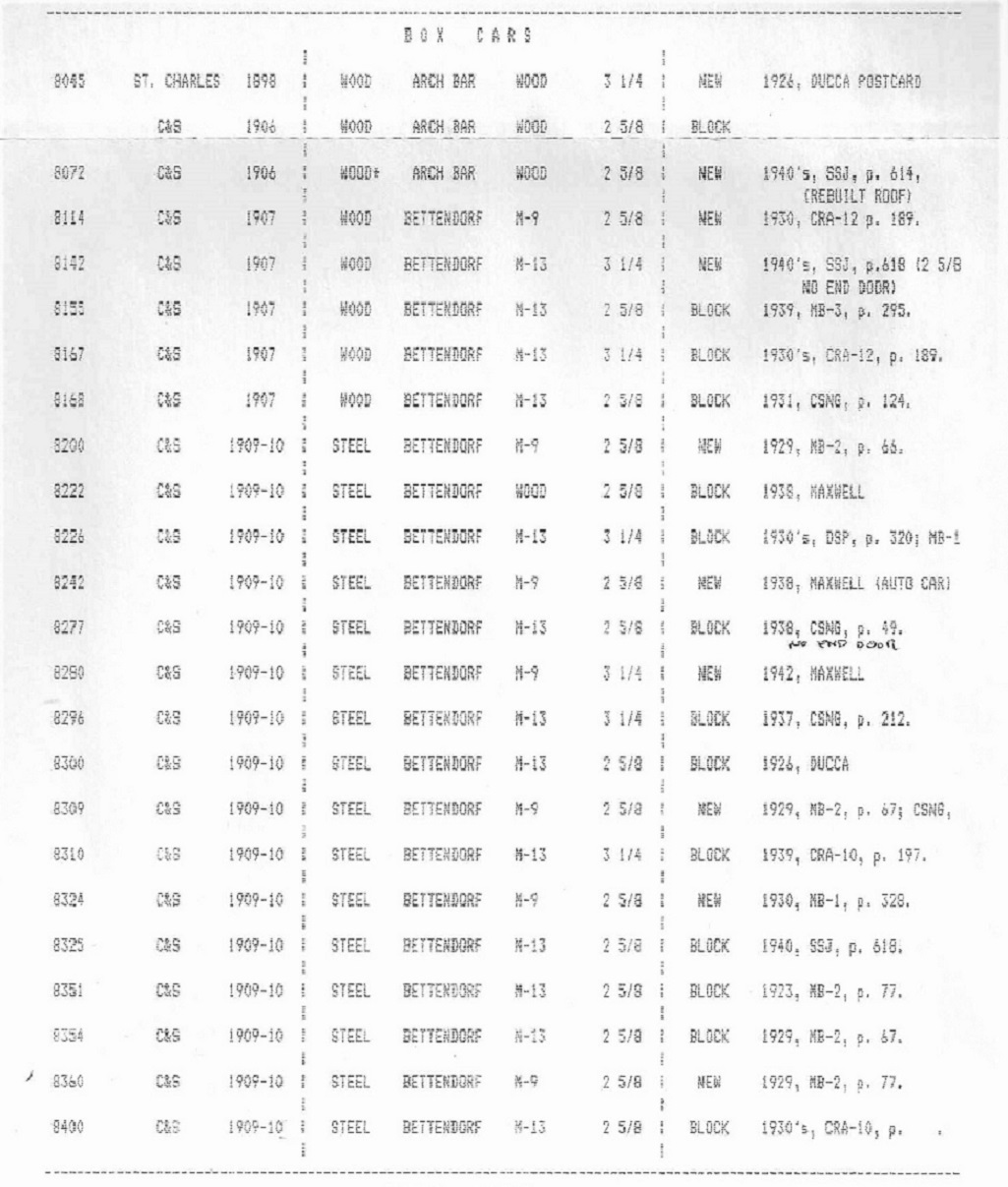 Columns (left to right): Car number, Builder, Year built, Underframe, Truck type, Roof type, Sheathing width, Lettering style in photo referenced, Photo source. Under the roof column, M-9 = 9 rib metal roof and M-13 = 13 rib metal roof.
Jim Courtney
Poulsbo, WA |
Re: How long did C&S boxcars stay in service?
|
In reply to this post by Jeff Young
It is a little later than your period but here is a list of cars I made years ago for 1929.
The list was made from "Equipment Registers" so I don't have individual numbers. It might give you some idea. Ken Martin Freight.doc |
Re: How long did C&S boxcars stay in service?
|
Very interesting. I have a couple of the Grandt Line kits, but haven’t built them yet. Sounds like I may have a bit of fettling to do on them….
Thanks for all the info, Jim and Ken! Cheers, Jeff. |
Re: Modelling a Type 3 boxcar in HOn3...
|
In reply to this post by Jim Courtney
Jim, this is great, thanks so much!
This means that the 13-rib roof is the "narrow" one as discussed by Derrell Poole in his NG Pictorial VIII text. According to him these proved less than satisfactory, panels tending to come loose as the cars flexed on rough track, hence the later replacement with either the wider 9-panel outside Murphy (why that was better I don't know) or in some cases wood roofs. So I guess one could build a model with a flapping roof panel or two during the '20's when maintenance was poor. Thanks also for the information on car height. By your description it would seem the correct solution would be to add to the fascia width. Indeed, comparing photos of the SUF cars in NGPict VIII with a photo of a built kit on the Grandt website, I can see that the fascia on the kit is too narrow by an amount consistent with your suggestion. If I can find a Grandt kit to build, that's what I'll see if I can do. thanks again, John John Greenly Lansing NY
John Greenly
Lansing, NY |
Re: Modelling a Type 3 boxcar in HOn3...
|
In reply to this post by Jim Courtney
Thanks, Jim. Here is a photo with a PIII box car next to a stock car. The box is Overland/PBL and the stock is PBL.
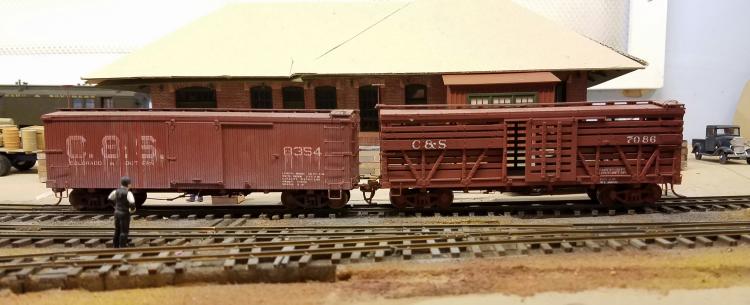 I never really noticed that the box was shorter. I guess it is.
Keith Hayes
Leadville in Sn3 |
«
Return to C&Sng Discussion Forum
|
1 view|%1 views
| Free forum by Nabble | Edit this page |


